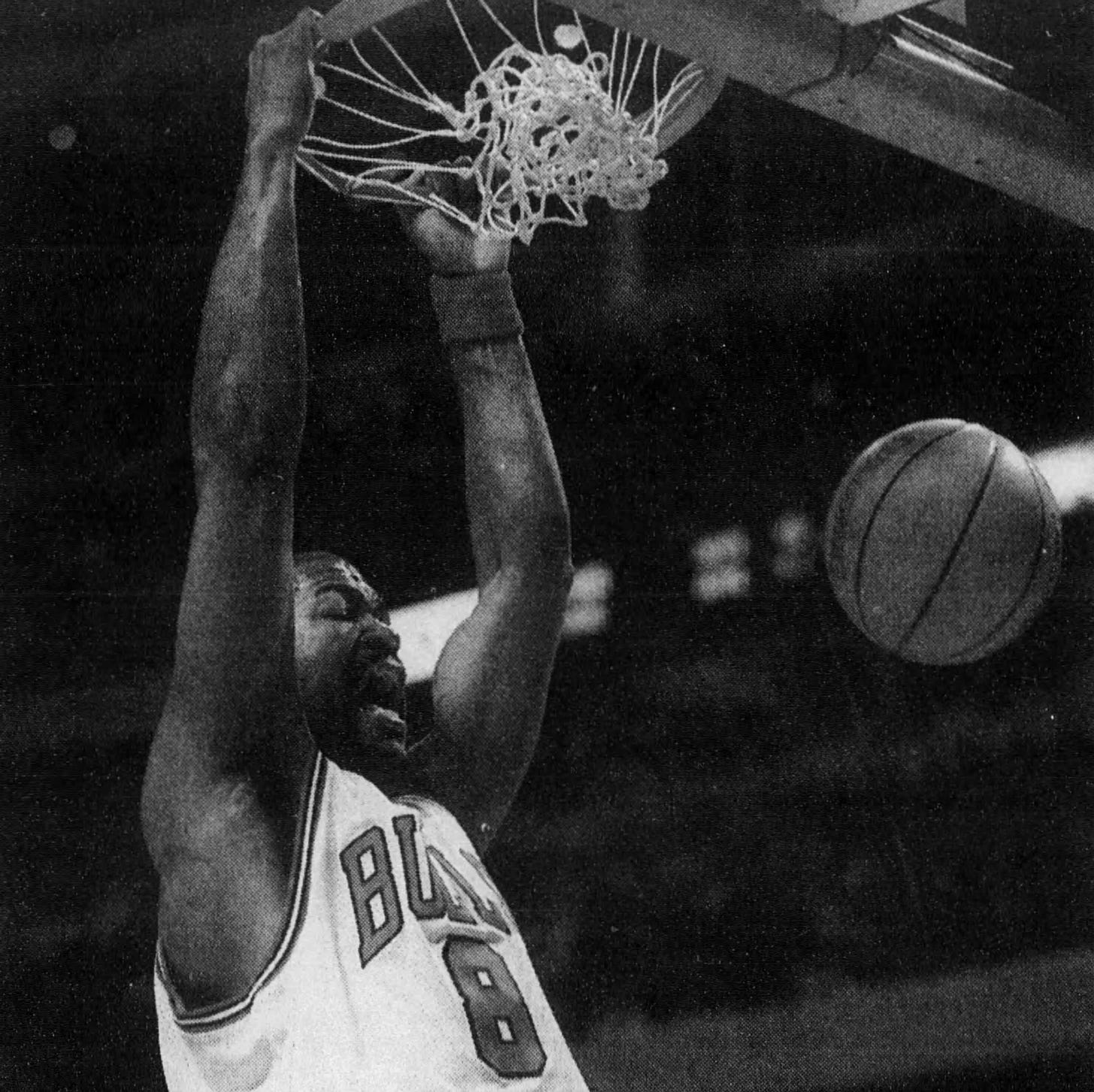
When I first heard about The Last Dance in May of 2018 and then saw the first trailer that December, I had the same reaction as every person who loved that team: HERE WE GO!
I also had another, perhaps more rare reaction: I can’t wait to see the Dickey Simpkins material!
This is not a joke.
That first trailer made The Last Dance seem like it was going to be a movie about the ‘98 Bulls. Now, any Bulls movie is going to be heavy on MJ. That’s a given, and that’s as it should be. But based on that trailer, I was picturing something closer to The Jordan Rules or Roland Lazenby’s Blood on the Horns, books that tell the story of a Bulls season from as many perspectives as possible.
And of all the players, coaches and other perspectives on the ‘98 Bulls that are possible, to me, one of the most fascinating is easily Dickey Simpkins.
Don’t remember Dickey’s wild 1998 season?
Let me tell you all about it.
“The only (expletive) guy on this team who’ll set a pick is Dickey.”
Dickey Simpkins just wanted to play.
That was as true entering the ‘97-’98 season as it was his rookie year.
Drafted 21st overall in 1994, Simpkins’s playing time in his first three seasons was scant. By the middle of March of his rookie year, Simpkins had played just 49 of the team’s 65 games. When he did play, he averaged just 9.5 minutes per game.
Enter Michael Jordan. For Simpkins, MJ’s return from baseball was both a burden and a boon. As Sam Smith reported in his book Second Coming1, when the Bulls placed the healthy Simpkins on the injured list to open a roster spot for Jordan, Simpkins was so fed up with being on the injured list without injuries that he was “threatening to go to the league.”
The flip side was that Jordan took Simpkins under his wing. With Horace Grant in Orlando, power forward had been a roster problem all year. MJ, who seemed to always appreciate big men who would be physical, especially on his behalf2, embraced Simpkins as, Smith wrote, a potentially new Charles Oakley, “a burly player who might come to Jordan’s defense, something of a policeman.”
Grant’s first replacement was NBA veteran Larry Krystkowiak, who joined the Bulls that season and started opening night. But Krystkowiak battled injuries — real ones — and then battled Jordan, who during one game took issue with the team’s lack of enforcers.
“He looked at me and Jud,” Krystkowiak told Smith, “and he said, ‘The only fuckin’ guy on this team who’ll set a pick is Dickey.’”
When Jerry Krause and Phil Jackson picked second-year power forward Corie Blount for the playoff roster over Simpkins, Jordan was irate, screaming at Phil in the Berto Center kitchen where Phil had brought MJ to tell him the news specifically to avoid any conflict.
“Whose fucking idea was this?” Jordan shouted. “Is this Krause’s idea?” The Bulls got out-muscled by Orlando in the playoffs and Krause, Phil and even MJ went hunting for power forwards3.
I can imagine Dickey seeing all of Jordan’s rage and indigence on his behalf, combined with the team’s clear PF problem, and think that he was set to soar in 1996. Instead, Krause spent a fifth straight 1st-round pick on a power forward4, this time Jason Caffey. He did deal Blount to the Lakers, so 1996 would be the Simpkins-Caffey battle after the Blount-Simpkins battle.
Or not.
Because of course in October, Krause traded for Dennis Rodman, relegating Simpkins v. Caffey to the undercard. With more bigs additions in James Edwards (Oct. 1995) and John Salley (March 1996), both young PFs were left off the playoff roster. They had front-row seats to history but no place on stage.
The 1997 season saw advancement for Caffey and not for Simpkins. Dickey played 48 games with zero starts and a team-low 8.2 minutes per game for every Bull but Matt Steigenga5. Caffey played 75 games with 19 starts as a replacement for either or both Dennis Rodman and Toni Kukoc. When those two missed the final 13 games of the season, Phil settled into a starting lineup with Caffey replacing Rodman.
Caffey opened the playoffs as the starting power forward of the NBA’s juggernaut. Simpkins missed the playoff roster a third time.
By the time the ‘97-’98 season came along, Simpkins had two championship rings and nary a playoff minute to show for it. With Dickey wanting playing time and the Bulls wanting a small forward to fill in for Pippen while he recovered from surgery, the Bulls traded Simpkins to the Warriors on September 27 in exchange for Scott Burrell.
“Rarely in this business does a trade work out for both teams,” Krause said after the trade. “This could be one of those times.”
The curious case of… the Latrell Sprewell case
The trade was good for Scott Burrell.
It did nothing for Dickey Simpkins.
Moving in 1997 from the Bulls to the Warriors must have been like a White House staffer getting shipped to work as an aid in a small town city hall. Dickey played three games, barely, made three of 11 shots and ended up back on the injured list.
“Nothing in this world surprises me,” Simpkins said. “It’s a business, man.”6
Timing for Simpkins, though, put him right in line for a view on one of the most infamous events in NBA history: Latrell Sprewell choking coach P.J. Carlesimo. Simpkins had seen Dennis Rodman suspended for headbutting a ref and kicking a cameraman, and neither of those had the impact of Spree choking P.J.
The Sprewell incident was December 1. On December 9, Sprewell held a press conference and was joined by several Warriors teammates. At the trade deadline, Golden State shipped out three of the players who stood behind Sprewell, starting with veterans Brian Shaw and Joe Smith. To make the trade math work, the Warriors waived Simpkins. Shaw spotted Simpkins at the airport.
“Man, what are you doing here? You got traded too?” Shaw recalled asking Simpkins.
Two days later, the Warriors traded another Sprewell press conference attendee: backup forward David Vaughn. The destination: the Bulls! To MJ’s and Phil’s shock and disgust, Krause sent Caffey to the Warriors for Vaughn and two second-round picks7, kept Vaughn for two weeks, played him in three games for six total minutes and then waived him to make room for...8
…Dickey Simpkins.
“He’s an intelligent player and he knows how to play with us,” Phil said about Dickey’s return. “The big thing is he gives us a big body to back up in case something happens at center.”
“When I was here, I did things professionally and was always working hard,” Simpkins said, adding: “This is a business. The business is, there’s never promises of anything.”
A playoff roster spot at last
In January of 1998, with his Warriors preparing for a game against his old Bulls, Simpkins reflected on being a bigger fish in a non-playoff pond.
“If I was still in Chicago, I really don’t think it would be the best situation for me,” Simpkins said.
Fast forward three months and here he was, back in Chicago, and if Dickey knew that this was indeed the best situation for him, he was the only one. As the season wound down, the question loomed about the final playoff spots. MJ, Scottie, Dennis, Harp, Luc, Toni, Kerr, Burrell, Buechler and Brown were locks. Rookies Keith Booth and Rusty LaRue were definitely out. Three vets remained for two spots: Bill Wennington, who seemed likely but had missed the ‘97 playoffs, Joe Kleine, and Simpkins.
Rolling with Simpkins plus one center seemed like the path forward, but an injury to Luc Longley late in the year made Phil wonder if he would need to have both centers on the playoff roster, leaving Simpkins out once more.
Instead, Dickey produced his best game as a Bull on April 7 against Washington, with a career high 17 points on 6-8 shooting, helping the Bulls win as they battled Utah for the league’s best record.
“This was not a statement game,” Simpkins said about the notion that he was trying to convince Phil to keep him for the playoffs. “I just tried to play my role with aggressiveness.” He told Phil he was focusing on the “three Cs”: “being comfortable, confident and consistent.”
The work paid off: Phil named Simpkins to the playoff roster.
“We (were) in a tough situation — we have 13 quality NBA players who can play in the playoffs,” Krause said. “We could only pick 12. I left decision totally up to Phil.”
Jackson thought that Simpkins would be valuable in the 1st round against the Nets, after which Longley would return and they would be back at full strength at center.
“Phil feels — and certainly I think it has been backed up very strongly — that Dickey Simpkins has done a fine job for us,” Krause said. “When we got Dickey back, that was one of the things we talked about at some length.”
Simpkins had solid contributions in the sweep against the Nets, including 18 minutes in Game 1, and played in 11 of the team’s 15 playoff games before the Finals. Though he spent the Finals rematch against Utah at the end of the bench, Phil presumably leaned on him big in practice. In his 2004 book The Last Season, Phil wrote that Simpkins “was unstoppable in practice and helped us prepare for Karl Malone.”
I don’t know if that refers to 1997 or 19989 but anything Simpkins did in 1997 to help the Bulls prep for Malone would have been just as valuable in 1998, when the only power forwards on the team were Rodman and Simpkins. While Simpkins, Wennington and Randy Brown were at the end of Phil’s bench in the Finals, all three of them were part of the greatest beatdown in Finals history, a 42-point win in Game 3.
Jackson subbed those three in for the final 5:22, and all three scored, making the Bulls a perfect 12-for-12 that day for players scoring. Simpkins’s bucket, an uncontested dunk, triggered a joyous, much replayed celebration from Pippen, Harper and Jordan as they rested on the bench.
“I’m having fun and I’m being focused,” Simpkins had said in April, back when he did not yet know if he would be on the playoff roster. “I’m just taking every game one game at a time and every day one day at a time.”
Beating MJ in one-on-one… and winning his most meaningful ring
The Bulls went up 3-1 with a win in Game 4, and then Jordan’s missed buzzer-beater to end Game 5 shifted the series back to Utah. The morning after the loss, the Bulls had a short workout at the Berto Center. After practice ended, Jordan played some teammates in one-basket one-on-one. As K.C. Johnson reported for the Tribune,10 Jordan beat Ron Harper with a 20-foot jumper, knocked out rookie Keith Booth on a driving layup and then beat rookie Rusty LaRue with a pull-up jumper.
When Jordan finally missed, it was against Dickey, who nailed his own jumper for the win. K.C. reported Jordan walking off the court “smiling and laughing” while Simpkins, per the AP, was “shimmying around the court.” The Bulls won the title the next day. Though he did not play, Simpkins finally had the joy of wearing a jersey when the final gun signaled another Bulls championship.
When Joe Kleine was left off the playoff roster, he was happy for Dickey, disappointed for himself, but ultimately had a positive outlook: “You’re on the damn Bulls (and) you could be on the Nets.”11
I don’t know but I bet Dickey Simpkins felt similarly: You could be on the Warriors — and you’re on the damn Bulls.
-
-
-
Salute to Dickey Simpkins, and thanks for reading everyone!
Also, a big thank you to Brendan of Sports Book Reviews on Substack. When I was looking for a copy of Phil Jackson’s book to get his Simpkins section, I contacted Brendan, who I’ve never met, and he went looking for the book in his collection. He didn’t have it at home (he’s got a big collection and it was elsewhere!) but he looked for me and I appreciate that. Thanks man! His site is here:
The following is from pages 178-179 of Second Coming.
As Sam Smith reported in The Jordan Rules, MJ appreciated big man Ed Nealy, who the Bulls had to let walk in 1990 for salary reasons. Wrote Sam: “Jordan respected Nealy, even if he doubted his overall athletic talent, for Nealy was the basketball version of rolling up your sleeves, spitting on your hands, and going to work. Jordan would always go to Nealy’s side of the court when they were playing together, no matter where Jordan was supposed to be in that particular set. ‘He’s the only one who’ll set a good pick,’ Jordan said. ‘He’s a tough guy.’”
Jordan took the uncommon, for him, step of personally recruiting Nets power forward Jayson Williams, trying to meet him at a night club in Greenwich Village.
Krause’s 1st round picks from 1991 to 1996: 1991 #26, Mark Randall (Kansas); 1992 #27, Byron Houston (Oklahoma State); 1993 #25, Corie Blount (Cincinnati); 1994 #21, DICKEY SIMPKINS (Providence); 1995 #20 Jason Caffey (Alabama); 1996 #29, center Travis Knight (UConn).
Steigenga spent the 1996 training camp with the Bulls. As he told me: “I got to know Jason Caffey, Dickey Simpkins, guys like that who would have to play in those summer leagues.”
Dave Del Grande in the Oakland Tribune, Nov. 10, 1997: “The Golden State Warriors recorded a franchise first Sunday when Dickey Simpkins was put on the injured list with — get this — a strained right pectoralis muscle.” Del Grande referred to it as a “so-called” injury.
The picks — the first was a 1998 2nd rounder, which we used on UNC guard Shammond Williams, who we traded on draft night for fellow 1998 rookie Cory Carr + a 1999 2nd round pick (Lari Ketner, RIP) + a 2000 2nd round pick (the great Khalid El-Amin). The second pick was a 2000 2nd rounder, which we used on IU legend A.J. Guyton. To sum up, Krause traded Simpkins for Burrell, then traded Caffey for Vaughn and picks that became Cory Carr, Lari Ketner, Khalid El-Amin and A.J. Guyton, and then waived Vaughn to resign Simpkins.
Five days after the Bulls waived him, David Vaughn signed a 10-day contract with the Nets. On March 16, he was back in Chicago as a member of the opposition, playing 22 minutes and blocking one of MJ’s shots.
This could be 1997, considering Dickey was not on the playoff roster, and Phil opens the section with this: “In past seasons players who weren’t on the playoff roster were able to take part, replacing those with aches and pains, allowing everyone else to get in the necessary work. We taught them how to run the opponent’s offense. They didn’t learn the whole system, but enough plays to simulate the challenges the starters and main reserves would be facing.”
As Joe Kleine told me: “It sucked. I’m not going to lie to you. I was hurt. I wanted to play and really be a part of it. But I understood. Bill was going to be on the roster. He had done too much for them in the playoffs and played too good for them in the playoffs. That was never in doubt. And I understood Dickey. He had been there two years longer than I had and he had paid his dues.”




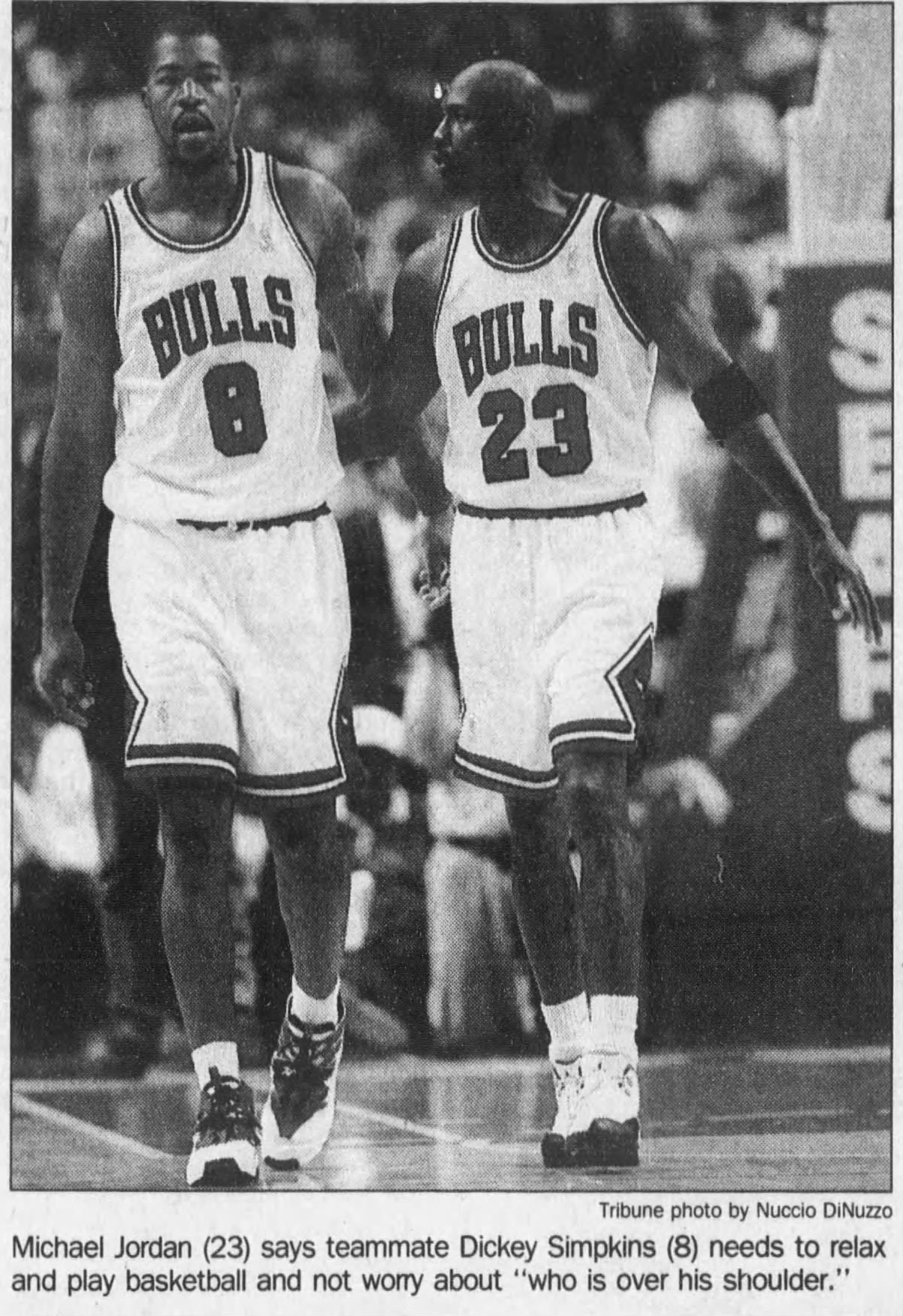
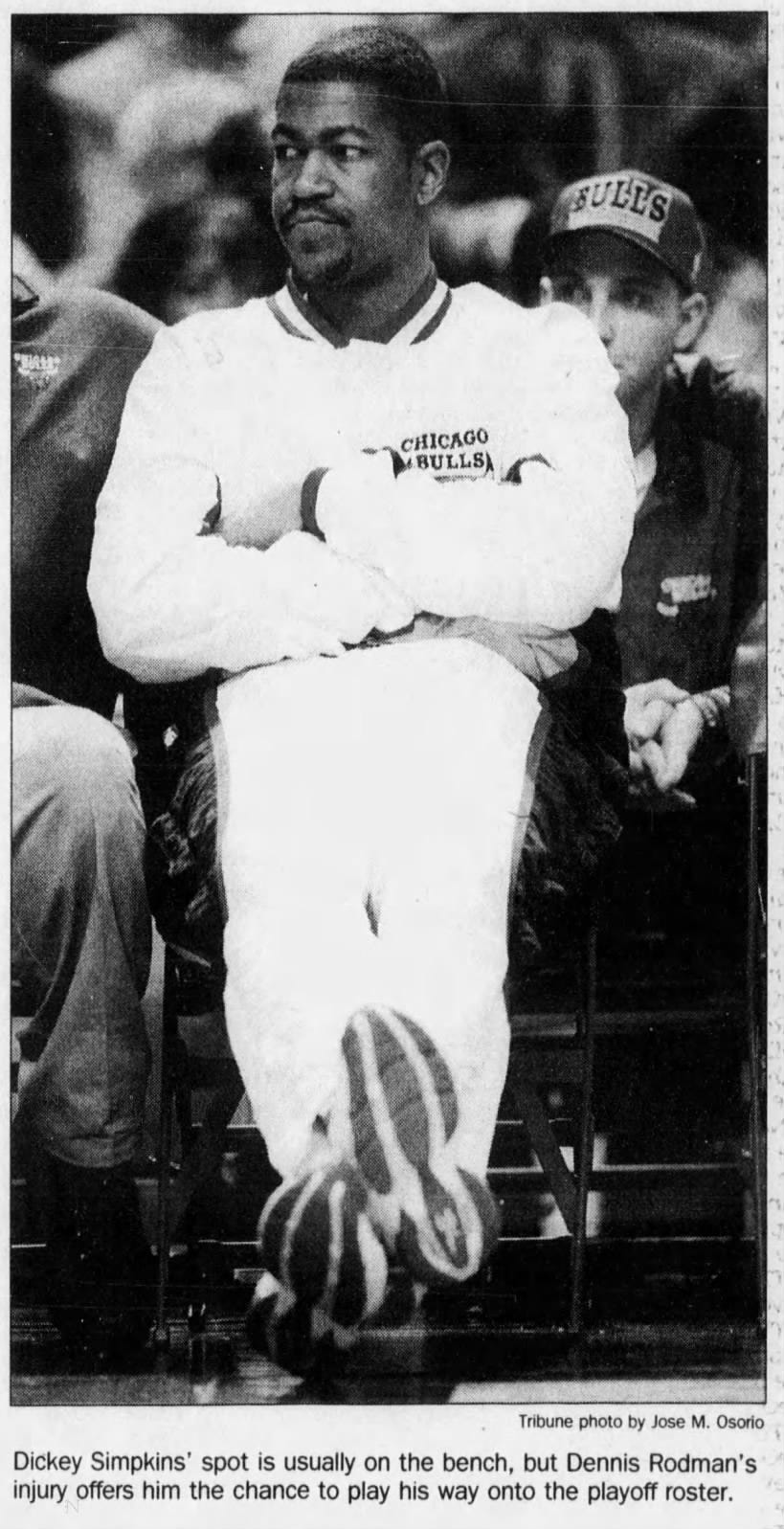
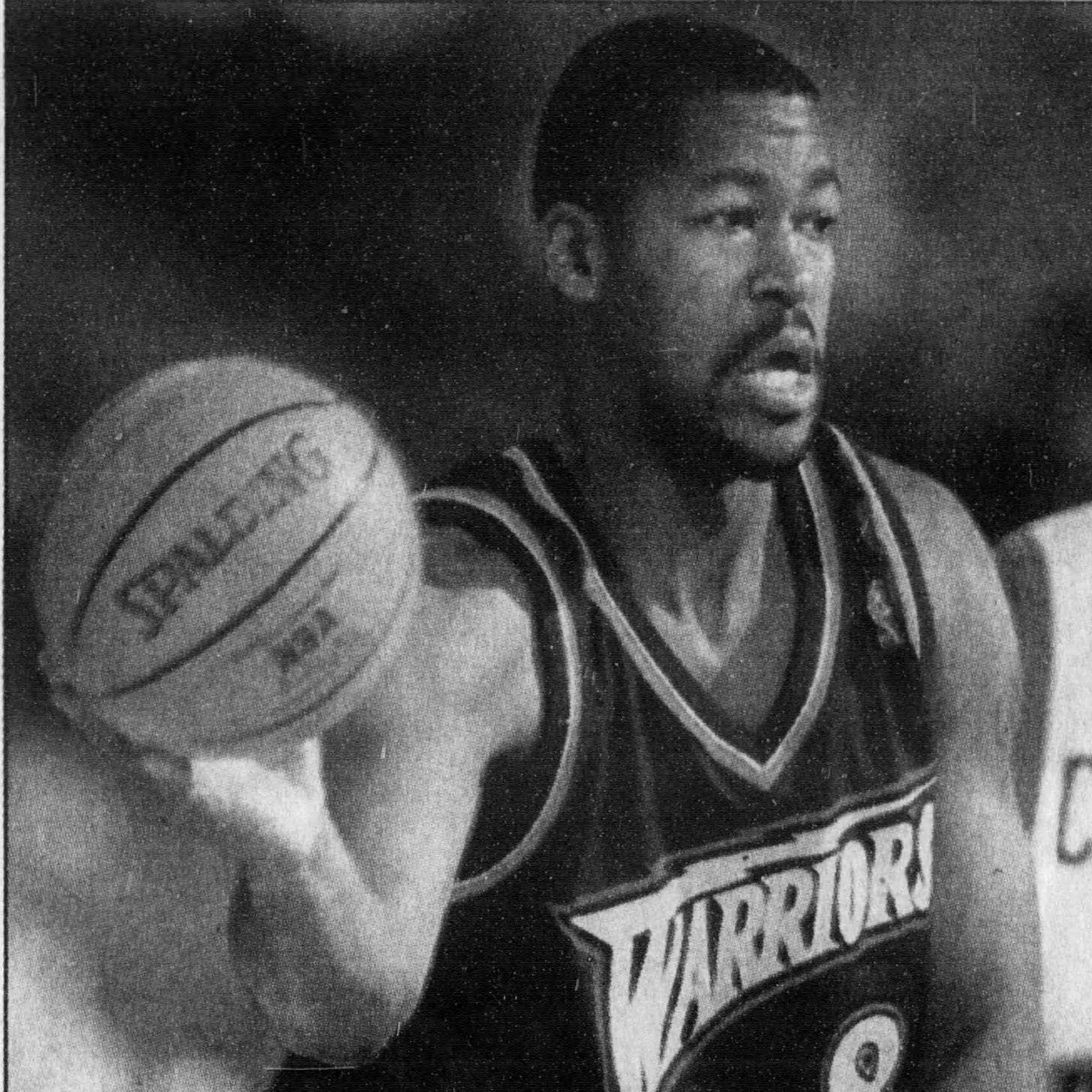
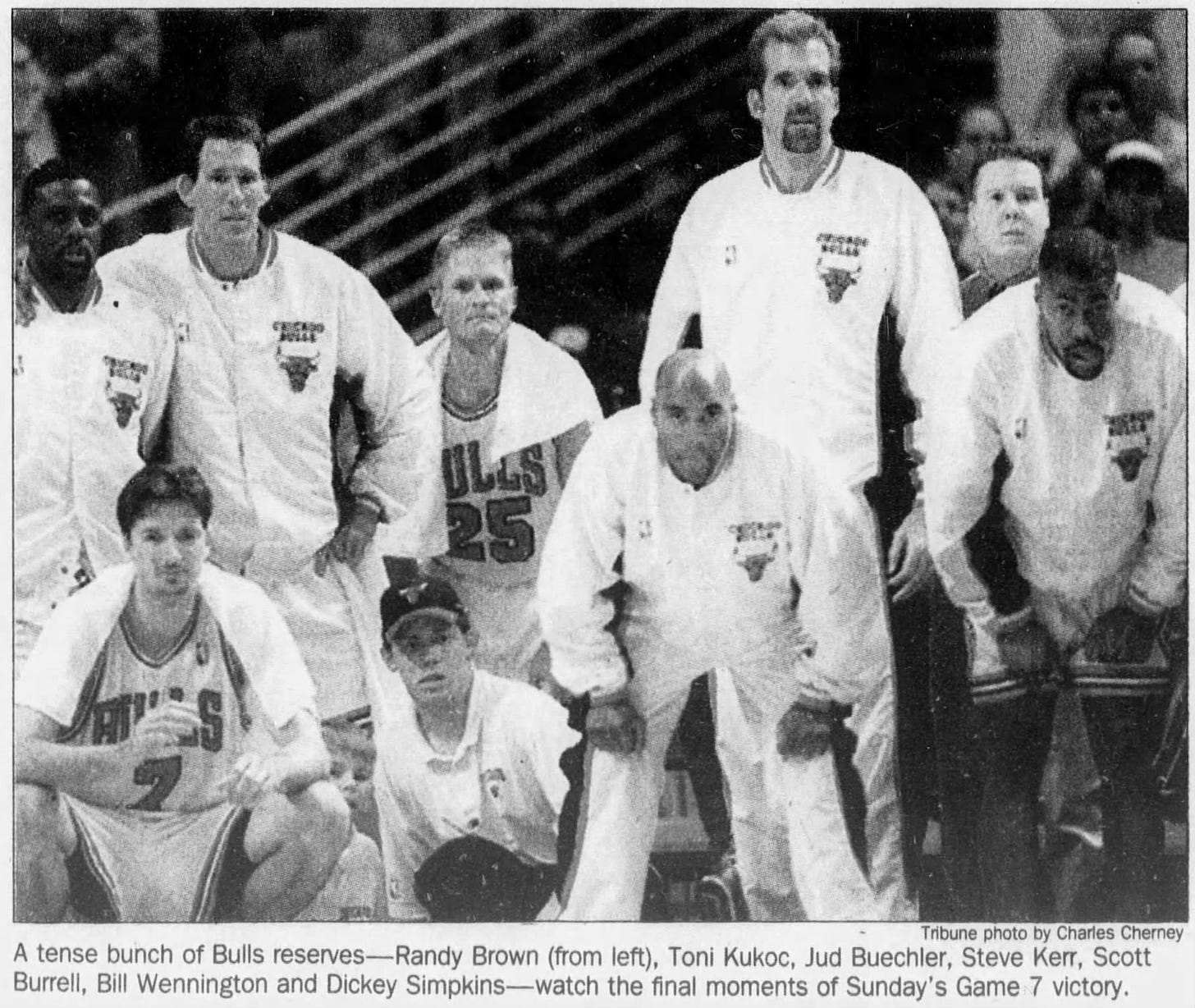


I didn't finish reading yet but I already purchased Blood on the Horns